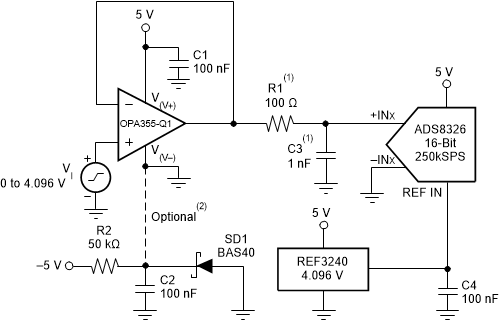SLOS868C December 2013 – May 2018 OPA355-Q1
PRODUCTION DATA.
- 1 Features
- 2 Applications
- 3 Description
- 4 Revision History
- 5 Device Comparison Table
- 6 Pin Configuration and Functions
- 7 Specifications
- 8 Detailed Description
- 9 Application and Implementation
- 10Power Supply Recommendations
- 11Layout
- 12Device and Documentation Support
- 13Mechanical, Packaging, and Orderable Information
Package Options
Refer to the PDF data sheet for device specific package drawings
Mechanical Data (Package|Pins)
- DBV|6
Thermal pad, mechanical data (Package|Pins)
Orderable Information
9.2.3 Driving ADCs
The OPA355-Q1 op amps are designed for driving sampling analog-to-digital converters (ADCs) with sampling speeds up to 1 MSPS. The zero-crossover distortion input stage topology allows the OPA355-Q1 device to drive ADCs without degradation of differential linearity and THD.
The OPA355-Q1 device can be used to buffer the ADC switched input capacitance and resulting charge injection while providing signal gain. Figure 35 shows the OPA355-Q1 device configured to drive the ADS8326.

1.
NOINDENT:
Suggested value; may require adjustment based on specific application.2.
Figure 35. Driving the ADS8326
NOINDENT:
Single-supply applications lose a small number of ADC codes near ground as a result of op amp output swing limitation. If a negative power supply is available, this simple circuit creates a –0.3-V supply to allow output swing to true ground potential.